The following is an address given by Captain Ralph T. Derbidge MBE RAN (Retired) on Monday 19 October 2015 at the Australian War Memorial. The occasion was the dedication of a commemorative plaque honouring two ships of Her Majesty’s Australian Fleet that bore the name HMAS Brisbane, and all who crewed them. The purpose of the address was not to describe the two ships in any great detail but to provide a picture and understanding of the people who manned them.
The two ships served the nation for a combined total of 53 years but their initial commissioning dates were separated by almost as many years. They were both steam driven and of near same size. As an aside, the de-commissioning in 2001 of HMAS Brisbane (II) marked the end of steam propulsion for the Royal Australian Navy.
Each ship earned wartime battle honours but their appearances, fit outs and capabilities were vastly different. Similarity amounted to little more than the grey paint that covered their hulls. The one common denominator, as it has always been, was the calibre and competence of the all-male crews of those years that manned them. They were good, those men; they knew it and you could not tell them much!
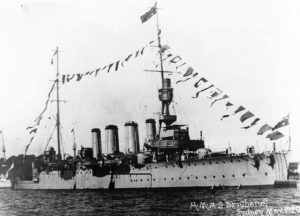
The replacement in 1913 of the Royal Navy’s Australian Squadron by a purpose-built Australian Fleet, led by the then modern battle cruiser HMAS Australia, did not happen overnight or without the expenditure of significant national treasure. Moreover, determined political will was vital to the process.
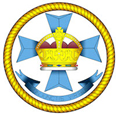
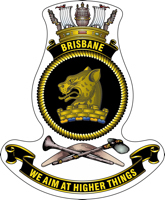
That process led to the addition to the Fleet in 1916 of the Town Class cruiser HMAS Brisbane (I), built here in Australia. She was a credit to the skills and resourcefulness of the fledgling major warship construction team assembled at the then Cockatoo Island Naval Dockyard in Sydney. Poignantly, reminders of the ship, her personnel and the dockyard have been consigned to the pages of history.
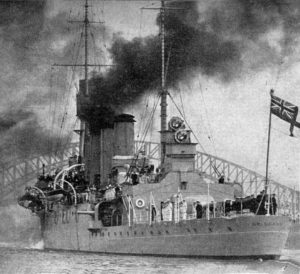
HMAS Brisbane (I) Departing Sydney on 2 May 1935. RAN image
We might be forgiven for focussing hereafter in some detail on her namesake, HMAS Brisbane (II), for her legacy is still firmly in the minds of many of us here. Furthermore, substantial and significant traces of her are to be found on and off-shore in south-east Queensland, and proudly on display here in this hallowed place. She was built in the United States of America and commissioned there in 1967, the third of three Perth Class guided missile destroyers built to the design of the United States Navy’s very successful Charles F Adams Class, but with some modifications.
She and her sister ships, Perth and Hobart, brought to the Royal Australian Navy new technologies of automation and computerisation and, for the first time, a real and potent surface-to-air missile system and, to be personally parochial, a medium-range gunnery system that worked. She was destined to give 34 years of remarkable service to the nation and the memory of her found a place of genuine and deep affection within the hearts of all who served in her.
Soon after commissioning, she was to be tested in the Vietnam War where her extremely professional and effective contributions in two seven-month deployments in 1969 and 1971 to that troubled theatre drew high praise. A measure of that involvement was that she fired some 14,000 rounds (or 435 tonnes) of high explosive 5-inch ammunition from her two gun mounts while operating on what was known as the Vietnam Gunline. In that war, her tactical call-sign aptly was Flamboyant and she concluded replenishment at sea evolutions from supply ships with an appropriate, loud-speaker blaring, replaying of the Credence Clearwater Revival hit-song Proud Mary. In this context, I am pleased to acknowledge the presence with us today of my commanding officer at the time of the second deployment to Vietnam 44 years ago, the then Captain Geoffrey Loosli CBE, now Rear Admiral (Retired)[1].
The ship again would be committed to combat operations twenty years later in the First Gulf War where she served once more with distinction. I pay homage to her commanding officer in that conflict, the now retired Vice Admiral Chris Ritchie AO and former Chief of Navy. He also is with us today. By this time, the ship was well known in, and beyond the Fleet, as The Steel Cat. Towards the end of her working life, still bristling with pride, she remained a unique operationally capable unit of the Royal Australian Navy with an unmatched weapons suite and associated command, control and communications combat data system. That capability, and much more, will be returned to the Royal Australian Navy when a newly-named HMAS Brisbane (III) is commissioned within the next few years. She will be one of three large and powerful air-warfare destroyers being built here in Australia.
Allow me to close on a somewhat sombre note, but with uplifting undertones. All sailors die; some in the red flash of battle, some in the white cold of a nursing home. In the vigour of youth, or the infirmity of age, all will eventually die. But the Royal Australian Navy lives on, and every sailor who ever lived, and served in that navy, is living still within its heritage.
We sailors here understand this, for we are the progeny of that navy and thus the custodians, if you will, of the memory of the two fine ships about to be honoured in the grounds of this venerated place. It is that link which gives us a sense of belonging to something that will outlive our own mortality.
The experiences and camaraderie we once shared afloat remain manifest, here and now, but one day, all of us will get separated from each other; we will miss our conversations of everything and nothing; the dreams that we had. Days will pass by, months, years, until this contact becomes rare. Eventually, our children and grandchildren will see our navy photographs and ask, “Who are these people?”
Then, because our hearts have been touched, we will smile with invisible tears, and we will say quietly: “It was with them that I had the best days of my life.”
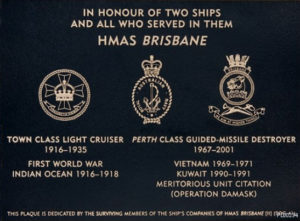
Further Reading
HMAS Brisbane (I) History published by Sea Power Centre-Australia, available at https://www.navy.gov.au/hmas-brisbane-i
HMAS Brisbane (II) History published by Sea Power Centre-Australia, available at https://www.navy.gov.au/hmas-brisbane-ii
HMAS Brisbane in the Far East 1925, by Greg Swinden, first published in the Naval Historical Review 2016, available at https://navyhistory.au/hmas-brisbane-in-the-far-east-1925/
[1] Rear Admiral R Geoffrey Loosli CBE RAN (Retired) passed away on 5 September 2016, aged 90 years




